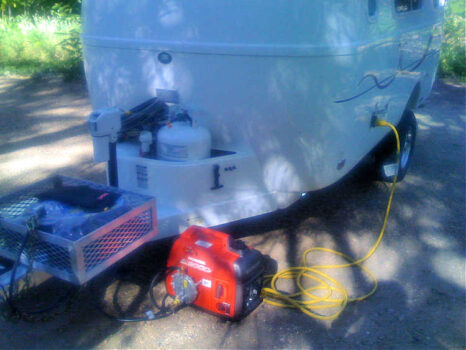Power. More power.
Having enough electricity to run all of your accessories and gadgets while you’re parked a million miles from nowhere… That’s what it’s all about!
Most motorhomes come equipped with on-board generators that will supply enough power to operate everything that’s contained within your RV.
By pressing a simple switch on the wall in your RV living room, the faint rumble of the engine immediately comes to life — and the flashing green 00:00 display on your microwave assures you that all is right with the world.
Does it always work this easily?
Sadly, it may take a little more effort sometimes.
Here’s everything you need to know about your RV’s generator — and how to troubleshoot generator problems…
RV Generator Placement
Your onboard generator is a separate diesel, propane, or gas-driven engine that’s usually mounted under your RV — often toward the rear of the unit.
For the health and welfare of those inside, this is the most logical place to locate something that produces dangerous fumes while you may be sleeping inside. Open to the elements, the exhaust can dissipate quickly. As long as you don’t have a window near the exhaust open allowing fumes to enter the interior, you have a safe source of electrical power.
This openness to the atmosphere is what can cause maintenance headaches. Dirt, dust, rain — even snow — that is kicked up by the tires or infiltrates into the generator when you’re traveling off the pavement can ruin the reliability of your generator very quickly.
Maintaining a clean environment for your generator will not only extend its life, but will go far in keeping it reliable!
This includes regular oil changes and replacing the all-important air filter on a regular basis. (How often you change your air filter is determined by the type of use it sees.) Good battery connections are also important.
Troubleshooting Onboard RV Generator Problems
Motorhome generators are often supplied with fuel from the same tank as the motor that propels you down the highway.
Generally, they’re plumbed in such a way that if your fuel supply is below ¼ tank, the fuel supply cuts off to the generator. This is done to keep you from stranding yourself by unknowingly exhausting your fuel supply.
If you press the button on the interior of your motorhome and the generator doesn’t immediately start, then it’s time to go outside and investigate the reason.
Onboard generators have a starter button located at the generator — and for your second attempt, it is far safer (for both you and the generator) to try starting it right at the generator.
Here are some good onboard RV generator tips to remember:
- The generator has its own oil supply. If the oil level is allowed to go too low, most units are protected by a low oil shut-off. This will stop the engine if it’s running and will also prevent it from starting.
- Some generators are liquid cooled, as well. Again, if the coolant is low, they may overheat or refuse to start. Many times it’s the simple things that cause the most problems. Out of sight, out of mind can easily become a problem with onboard generators!
- Seeing fuel running on the ground (or smelling a strong odor of fuel) will alert you to the fact that you have a flooding situation caused by a stuck choke. You don’t want to cause a fire or damage the starter by excessively cranking the generator inside. It’s better to walk away and waiting plenty of time for any excessive fuel to evaporate.
Some fifth wheel trailers have provisions for installing a generator on-board. Usually, it will be a propane model — since that’s the type of fuel available on a trailer. The same rules apply… If you have any doubt that you might have a problem, be sure to deal with it up close.
Portable RV Generator Tips

Portable RV generators are becoming very popular these days. These quieter generators are being built by a number of different companies.
When you hook up to a portable generator, be sure to use the correct plugs and use cords of adequate size to handle the load of your electrical system. If your generator’s 30-amp outlet is of the twist lock variety, you’ll need to purchase the correct adapter to convert from the standard 3-prong RV plug.
If you’re not 100% confident that you know what you’re doing, then you’ll want to use the services of a professional — especially if you need to alter your RV electrical system in any way. Electricity is very dangerous. Caution must always be taken when working with and around your RV generator. Keep in mind… depending on the RV, you could be working with voltages as high as 220-volt! This can be deadly if not handled properly.
Safety should always be your top priority! Here are some of the most important portable generator safety tips:
- Never operate a portable generator close to your RV. Have it at least 25 feet away with the exhaust pointed away from your RV.
- Before refueling your generator, let it cool completely. Gas fumes can ignite easily when they come in contact with hot exhaust surfaces.
- As with any internal combustion engine, the length of time between uses can affect its reliability. For example, gasoline left to sit inside a portable generator for months at a time will turn to lacquer. This will damage the fuel system of your generator — so be sure to start and run your generator on a regular basis to keep fresh clean fuel in the carburetor.
By following these tips, you can rest assured that your RV will have plenty of electricity when the need for air conditioning arises …like while you’re boondocking far away from electrical connections!



